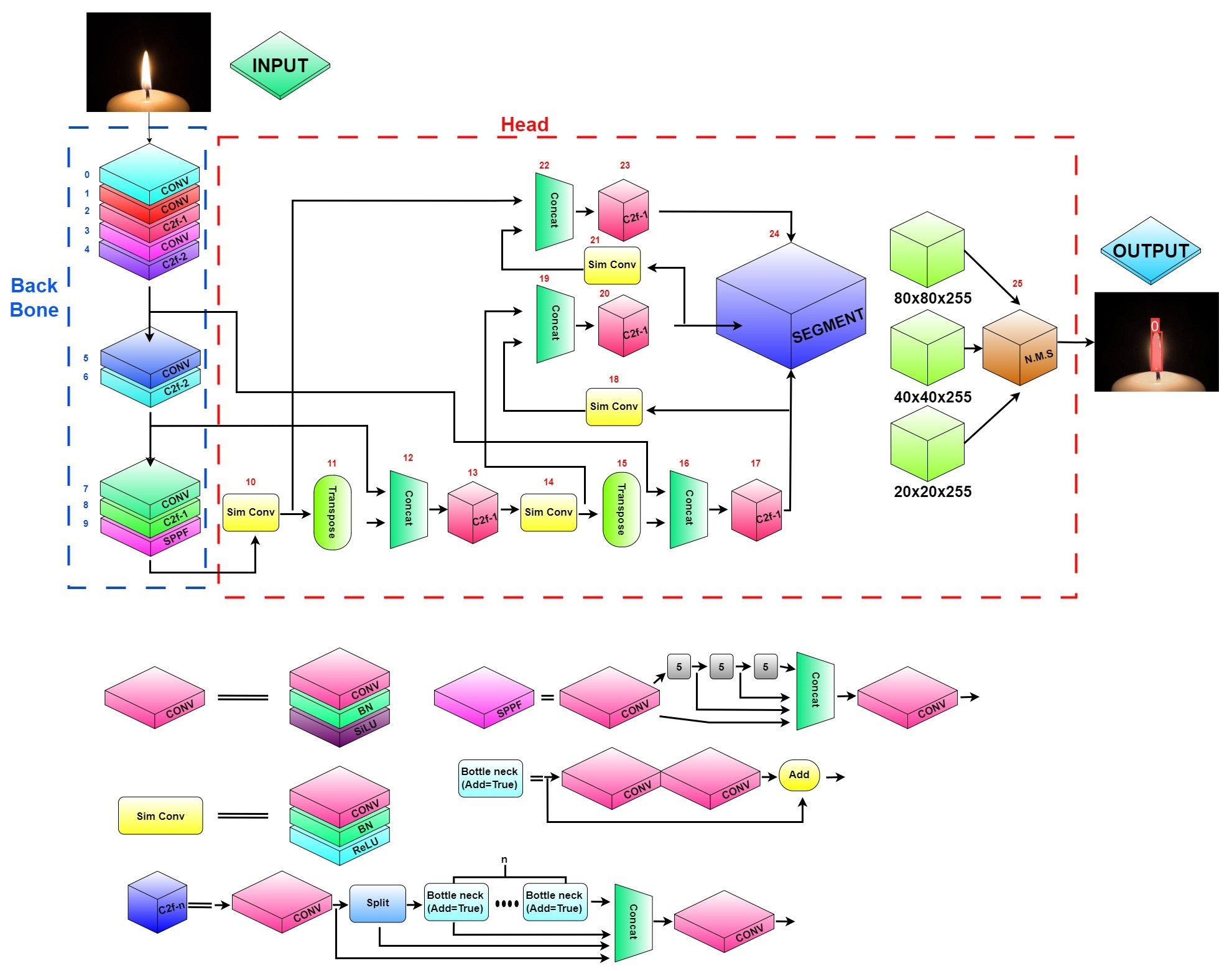Smart Fire Safety: Real-Time Segmentation and Alerts Using Deep Learning
Keywords:
Yolo-v8, Instance Segmentation, Fire and Smoke detection, Fire size, Fire spread, Emergency alert message, Arduino UnoAbstract
Fires are the major causes of property damage, injuries, and death worldwide. The ability to avoid or reduce the effects of fires depends on their early identification. The accuracy and responsiveness of conventional fire detection systems, such as smoke detectors and heat sensors, are constrained. Computer vision-based fire and smoke detection systems have been suggested as a replacement for conventional systems in recent years. To tackle the challenges a robust real-time framework has been proposed, whereby, images are taken from cameras and using a custom train YOLOv8 object segmentation model smoke and fires are localized in the image which are then fed to an expert system for alert generation. The expert system makes decisions on the fire status based on its size and growth across multiple frames. Furthermore, A new dataset was meticulously curated and annotated for the segmentation task, to assess the efficacy of the proposed system, comprehensive benchmarking was conducted on the proposed dataset using a suite of benchmarks. The proposed system achieved an mAP score of 74.9% on the benchmark dataset. Furthermore, it was observed that employing segmentation for localization as opposed to detection, resulted in system accuracy improvement. The system can immediately identify fires and smoke and send accurate alerts to emergency services.
References
“Home Structure Fires report NFPA,” 2021, [Online]. Available: https://www.nfpa.org/Newsand-Research/Data-research-and-tools/Building-and-Life-Safety/HomeStructure-Fires
“Fire Hazards and Firefighting in Pakistan - Webinar Report - IIPS.” Accessed: May 08, 2024. [Online]. Available: https://iips.com.pk/fire-hazards-and-firefighting-in-pakistan/
“500 shops gutted in Lahore’s Hafeez Centre fire.” Accessed: May 08, 2024. [Online]. Available: https://www.thenews.com.pk/print/731453-500shops-gutted-in-lahore-s-hafeez-centre-fire
“Fire and rescue incident statistics: England, year ending March 2020 - GOV.UK.” Accessed: May 08, 2024. [Online]. Available: https://www.gov.uk/government/statistics/fire-and-rescue-incident-statistics-england-year-ending-march-2020
“Smoke Detectors.” Accessed: May 08, 2024. [Online]. Available: https://www.explainthatstuff.com/smokedetector.html
Z. Q. Zhao, P. Zheng, S. T. Xu, and X. Wu, “Object Detection with Deep Learning: A Review,” IEEE Trans. Neural Networks Learn. Syst., vol. 30, no. 11, pp. 3212–3232, Nov. 2019, doi: 10.1109/TNNLS.2018.2876865.
“Jocher, G., Chaurasia, A. and Qiu, J. (2023) YOLO by Ultralytics. - References - Scientific Research Publishing.” Accessed: May 08, 2024. [Online]. Available: https://scirp.org/reference/referencespapers?referenceid=3532980
W. S. Mseddi, R. Ghali, M. Jmal, and R. Attia, “Fire Detection and Segmentation using YOLOv5 and U-NET,” Eur. Signal Process. Conf., vol. 2021-August, pp. 741–745, 2021, doi: 10.23919/EUSIPCO54536.2021.9616026.
S. G. Zhang, F. Zhang, Y. Ding, and Y. Li, “Swin-YOLOv5: Research and Application of Fire and Smoke Detection Algorithm Based on YOLOv5,” Comput. Intell. Neurosci., vol. 2022, pp. 1–8, Jun. 2022, doi: 10.1155/2022/6081680.
X. Chen, Y. Xue, Y. Zhu, and R. Ma, “A novel smoke detection algorithm based on improved mixed Gaussian and YOLOv5 for textile workshop environments,” IET Image Process., vol. 17, no. 7, pp. 1991–2004, May 2023, doi: 10.1049/IPR2.12719.
G. Sun, Y. Wen, and Y. Li, “Instance segmentation using semi-supervised learning for fire recognition,” Heliyon, vol. 8, no. 12, Dec. 2022, doi: 10.1016/j.heliyon.2022.e12375.
A. Solórzano et al., “Early fire detection based on gas sensor arrays: Multivariate calibration and validation,” Sensors Actuators B Chem., vol. 352, p. 130961, Feb. 2022, doi: 10.1016/J.SNB.2021.130961.
F. Yuan, L. Zhang, X. Xia, B. Wan, Q. Huang, and X. Li, “Deep smoke segmentation,” Neurocomputing, vol. 357, pp. 248–260, Sep. 2019, doi: 10.1016/J.NEUCOM.2019.05.011.
Z. Jiao et al., “A Deep learning based forest fire detection approach using uav and yolov3,” 1st Int. Conf. Ind. Artif. Intell. IAI 2019, Jul. 2019, doi: 10.1109/ICIAI.2019.8850815.
H. Xu, B. Li, and F. Zhong, “Light-YOLOv5: A Lightweight Algorithm for Improved YOLOv5 in Complex Fire Scenarios,” Appl. Sci. 2022, Vol. 12, Page 12312, vol. 12, no. 23, p. 12312, Dec. 2022, doi: 10.3390/APP122312312.
et. al. Bhanumathi. M, “Fire Detection and Alarm Using Gaussian Blur Background Subtraction Technique,” Turkish J. Comput. Math. Educ., vol. 12, no. 2, pp. 929–934, Apr. 2021, Accessed: May 08, 2024. [Online]. Available: https://turcomat.org/index.php/turkbilmat/article/view/1103
F. M. Talaat and H. ZainEldin, “An improved fire detection approach based on YOLO-v8 for smart cities,” Neural Comput. Appl., vol. 35, no. 28, pp. 20939–20954, Oct. 2023, doi: 10.1007/S00521-023-08809-1/FIGURES/9.
S. N. Saydirasulovich, M. Mukhiddinov, O. Djuraev, A. Abdusalomov, and Y. I. Cho, “An Improved Wildfire Smoke Detection Based on YOLOv8 and UAV Images,” Sensors 2023, Vol. 23, Page 8374, vol. 23, no. 20, p. 8374, Oct. 2023, doi: 10.3390/S23208374.
W. Wahyono, A. Harjoko, A. Dharmawan, G. Kosala, and P. Y. Pranata, “A Comparison of Deep Learning Methods for Vision-based Fire Detection in Surveillance System,” ACM Int. Conf. Proceeding Ser., pp. 1–6, Dec. 2021, doi: 10.1145/3508072.3508074.
L. Hu, C. Lu, X. L. Li, Y. Zhu, Y. Lu, and S. Krishnamoorthy, “An enhanced YOLOv8 for flame and smoke detection with dilated convolution and image dehazing,” https://doi.org/10.1117/12.3012472, vol. 12970, pp. 604–608, Dec. 2023, doi: 10.1117/12.3012472.
P. V. A. B. de Venâncio, A. C. Lisboa, and A. V. Barbosa, “An automatic fire detection system based on deep convolutional neural networks for low-power, resource-constrained devices,” Neural Comput. Appl., vol. 34, no. 18, pp. 15349–15368, Sep. 2022, doi: 10.1007/S00521-022-07467-Z/METRICS.
X. Xie, K. Chen, Y. Guo, B. Tan, L. Chen, and M. Huang, “A Flame-Detection Algorithm Using the Improved YOLOv5,” Fire 2023, Vol. 6, Page 313, vol. 6, no. 8, p. 313, Aug. 2023, doi: 10.3390/FIRE6080313.
C. Bahhar et al., “Wildfire and Smoke Detection Using Staged YOLO Model and Ensemble CNN,” Electron. 2023, Vol. 12, Page 228, vol. 12, no. 1, p. 228, Jan. 2023, doi: 10.3390/ELECTRONICS12010228.

Downloads
Published
How to Cite
Issue
Section
License
Copyright (c) 2024 50sea

This work is licensed under a Creative Commons Attribution 4.0 International License.




















